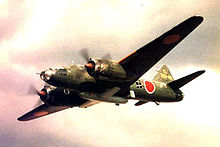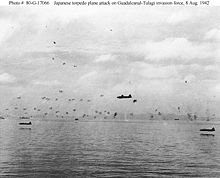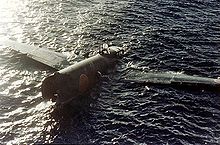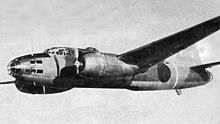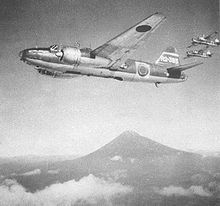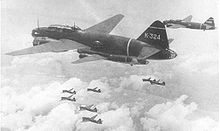- Mitsubishi G4M
-
Mitsubishi G4M Mitsubishi G4M1 of 801st Kokutai Role Twin-engine medium bomber Manufacturer Mitsubishi Designer Kiro Honjo First flight 23 October 1939 Introduction June 1941 Retired 1945 Primary user Imperial Japanese Navy Air Service Number built 2,435 The Mitsubishi G4M (or "Type 1 land-based attack aircraft")一式陸上攻撃機, 一式陸攻 Isshiki rikujō kōgeki ki, Isshikirikkō was the main twin-engine, land-based bomber used by the Imperial Japanese Navy Air Service in World War II. The Allies gave the G4M the reporting name Betty. The Allies usually gave Japanese fighters and floatplanes male names, while giving female names to bombers and reconnaissance aircraft. These code names did not come into general use until mid-1943.[1]
The G4M had a one-way range of about 3,700 miles which was achieved by its structural lightness and an almost total lack of protection for its crew, with no armor plating or self-sealing aviation fuel tanks. These omissions proved to be its weakness when opposition from American fighter aircraft increased during the second half of the Pacific War of World War II.[2]
Contents
Design and development
The G4M was designed for a long range and high speed at the time of its introduction. Consequently, several weight-saving measures were incorporated into the design, such as dispensing with self-sealing fuel tanks, which caused Allied fighter pilots to give it derisive nicknames such as "the one-shot lighter", "the flying Zippo" and "the flying cigar" because of their tendency to explode or catch on fire from any slight damage to the fuel tank wings after being hit by aerial machine gun fire or ground antiaircraft fire. Similarly, pilots of the Imperial Japanese Navy despairingly called the G4M "Betty" the "Type One Lighter", "The Flying Lighter" of the "Hamaki" ("cigar"). This was partially due to the fact that on many occasions, the G4M was used for low-altitude torpedo attacks on shipping in which their performance advantages were negated, and the G4M was frequently shot down by antiaircraft artillery fire, and even by small arms. The "Betty"'s relatively large size made it an easy gunnery target, and the predictable approach path required for a torpedo run made for a generally easy interception by Allied fighter aircraft.
When used for medium to high-altitude bombing against stationary land targets like a supply depots, seaports, or airfields, "ease of interception" was another matter entirely. Using its long range and high speed, the G4M could appear from any direction, and then it could be gone before many fighters intercepted them. The 20 mm cannon in its tail turret was much heavier armament than was commonly carried by bombers of either side, making aerial attacks from the rear quite dangerous for the Allied fighter aircraft. Sometimes, assuming they did not catch fire in the first place after being hit in the wings by flak from the ground or machine gun bullets from enemy fighters, G4Ms also proved to be able to remain airborne despite being badly shot up. For example, after the attack of the 751 Kokutai attack on the USS Chicago during the Battle of Rennell Island, three out of four survivors (out of 11 aircraft committed to the attack) returned flying on only one engine.
Towards the end of World War II (1945), the "Betty" bomber was commonly used for carrying and launching kamikaze aircraft, and was the usual aircraft for carrying the Ohka kamikaze manned rocket-powered bombs.
Production
- G4M1 Model 11: 1172 examples (including prototypes.)
- G4M2 Models 22, 22 Ko and 22 Otsu: 429 examples.
- G4M2a, Models 24, 24 Ko, 24 Otsu, 24 Hei, and 24 Tei: 713 examples.
- G4M3 Models 34 Ko, 34 Otsu, and 34 Hei: 91 examples.
- G6M1: 30 examples.
- Total production of all versions: 2,435 examples.
Operational history
The G4M was similar in performance and missions to other contemporary twin-engine bombers such as the German Junkers Ju 88 and Heinkel He 111 medium bombers, and also the American North American B-25 Mitchell and Martin B-26 Marauder bombers. These were all commonly used for antiship roles. The G4M Model 11 was prominent in attacks on Allied shipping in the 1941 to early 1944 time frame, but after that time, it was increasingly easy prey for Allied fighters.
The G4M's baptism by fire occurred on 13 September 1940 in Mainland China, when 27 "Bettys" and Mitsubishi C5Ms of 1st Rengo Kokutai (a composite force including elements of the Kanoya and Kizarazu Kokutais (Air Groups)) departed from Taipei, Omura, and Jeju City to attack Hankow. The bombers and reconnaissance aircraft were escorted by 13 A6M Zeros of 12st Kokutai led by the I.J.N. lieutenant, Saburo Shindo. A similar operation occurred in May 1941. In December 1941, 107 G4Ms based on Formosa of 1st Kokutai and Kanoya Kokutai belonging to the 21st Koku Sentai (Air Flotilla) crossed the Luzon Strait en route to bombing the Philippines, and this was the beginning to widespread invasion of the islands of the Southwest Pacific Theater.
As a torpedo bomber, the G4M's most notable use was in the sinking of the HMS Prince of Wales and the HMS Repulse off the eastern coast of British Malaya on 10 December 1941. These carried out the attacks alongside the older Japanese bombers, the Mitsubishi G3M "Nells" which were doing high-level bombing runs. The battleship Prince of Wales and the battlecruiser Repulse were the first two capital ships ever to be sunk exclusively by air attack during a war, while on the open ocean. Those bomber crews were a handful of selected Imperial Japanese Naval Air Force (IJNAF) aviators in prewar Japan, who had skills not only in torpedo-attacks at an altitude of less than 30 ft (9 m), but also in being able to navigate long-range flight over the ocean to pinpoint naval targets moving quickly on the sea. This same squadrons in Kanoya Air Group of Kanoya Kokutai (751 Ku), Genzan Air Group of Genzan Kokutai (753 Ku), and the Mihoro Air Group of Mihoro Kokutai (701 Ku). These sank the British capital battle ships, and they later carried out an extended series of attacks against U.S. Navy and Allied ships, and on land targets during the six-month-long Battle of Guadalcanal (in the Solomon Islands), in late 1942.
On 8 August 1942, the second day of the U.S. Marines landing on Guadalcanal, IJNAF's 23 G4M1s conducted a torpedo attack against American ships at Lunga point, Guadalcanal. A total of 18 of the attacking G4M1s were shot down, due to very heavy antiaircraft fire, and air cover from Grumman F4F Wildcat fighters based on three American aircraft carriers. In all, 18 Japanese crews – approximately 120 aviators– were missing at the beginning of the month. More than 100 Japanese G4M1s and their best crews (with no substitutes available) were shot down during the many following battles around Guadalcanal, from August through October 1942.[3] In the two days of the Battle of Rennell Island on 29 and 30 January 1943, 10 out of 43 Japanese G4M1s were shot down during night torpedo attacks, all by the U.S. Navy's antiaircraft fire. About 70 Japanese aviators, including Lieutenant Commander Higai, were killed during that battle.
Probably the best-known incident involving a G4M during the war was the attack resulting in the death of Isoroku Yamamoto. The G4M with tail number T1-323 - which was carrying the Imperial Japanese Navy Admiral Isoroku Yamamoto - was attacked and shot down by Lockheed P-38 Lightnings from 339th Fighter Squadron of the 347th Fighter Group, Thirteenth Air Force, USAAF on 18 April 1943.
The G4M Model 11 was replaced by Models 22,22a/b,24a/b,25,26 and 27 after June 1943, following service in New Guinea, the Solomons, and the South Pacific area, in defense of the Marianas and finally in Okinawa. Others had field modifications resulting in the Model 24j which carried suicide flying bombs Yokosuka MXY7 Ohka Model 11 beginning on 21 March 1945, with disastrous results due to extensive Allied fighter opposition.
From November 1944 to January 1945, G4Ms were one of the main types of aircraft used in the Japanese air attacks on the Mariana Islands, and plans to use converted G4Ms to land commandos on the islands were developed in mid-1945 and only cancelled at the end of the war.
Following the loss of Okinawa, G4Ms constituted the main weapon of the land-based Japanese naval bomber force, consisting of 20 Kokutais at the end of the war, including the testing air group equipped in 1944–45 with the latest version G4M3 Model 34 and 36 which arrived too late to have an impact on the war.
As part of the negotiations for the surrender of Japan, two demilitarized G4Ms, given the call-signs Bataan 1 and Bataan 2 were sent to Ie Shima carrying the first surrender delegations as the first leg of their flight to Manila, the Philippines.
Versions
G4M1
- G4M1 Prototypes
- Japanese Navy land Based Bomber Type 1. Two prototypes built.
- G4M1 Model 11
- Japanese Navy Land Attack Bomber Type 1. The first bomber model of series, with 1,140 kW (1,530 hp) Mitsubishi MK4A Kasei Model 11 engines driving three-blade propellers. Following modifications were made during the production:
- March 1942: The first aircraft (241st production example) fitted with MK4E Kasei Model 15 engines with larger superchargers for better high altitude performance, became standard in August 1942 from 406th aircraft onwards. These MK4E-engined aircraft have often (erroneously) been referred as the G4M1 Model 12.
- Summer 1942: Propeller spinners introduced.
- March 1943: From 663rd machine onwards, 30 mm (1.18 in) rubber ply sheets installed beneath the wing outer surfaces to protect the undersides of the fuel tanks (speed reduced by 9 km/h/6 mph and range by 315 km/196 mi), 5 mm (.2 in) armour plates added into tail gunner's compartment.
- Spring 1943: Outer half of the tail cone cut away in order to improve tail gunner's field of fire.
- August 1943: A completely redesigned tail cone, with reduced framing and wide V-shaped cut out; this form of tail cone was also used in all G4M2 models.
- September 1943: Individual exhaust stacks from 954th airframe onwards.
Production of the G4M1 ended in January 1944.
G4M2
The first of the four G4M2 prototypes flew in December 1942. It differed from the preceding model in having MK4P Kasei Model 21 engines with VDM Electric four-blade propellers capable of full feathering function, redesigned main wings with LB type laminar flow airfoil.[N 1] and widened tail horizontal stabilizer wing area, which improved service ceiling to 8,950 m (29,360 ft) and maximum speed to 437 km/h (236 kn, 272 mph). Main wing fuel tanks were enlarged to 6,490 L (1,715 US gal) which increased the range to 6,100 km (3,790 mi/ 3,294 nmi overloaded, one way). An electrically powered dorsal turret featuring a 20 mm cannon was introduced in place of G4M1's dorsal position with a 7.7 mm machine gun, total guns armed were 2 × 20 mm Type 99 cannon (1 × tail turret, 1 × top turret), 4 × 7.7 mm Type 92 machine gun (1 × nose, 2 × waist, 1 × cockpit side). External differences also included increased nose glazing, flush side gun positions instead of blisters, and rounded tips of wings and tail surfaces. These major improvements also made it possible for the G4M2 to carry more powerful bombs; 1 × 1,055 kg (2,326 lb) Type 91 Kai-7 (improved model 7) aerial torpedo or 1 × 800 kg (1,760 lb) bomb or 2 × 500 kg (1,100 lb) bombs or one Type 3 – 800 kg (1,760 lb) no.31 ray-detective type bomb + 12 × 60 kg (130 lb) bombs. This model, G4M2, was put into service in mid-1943.
 G4M2e Model 24 Tei launching suicide bomb Yokosuka MXY-7 Ohka "Baka"
G4M2e Model 24 Tei launching suicide bomb Yokosuka MXY-7 Ohka "Baka"
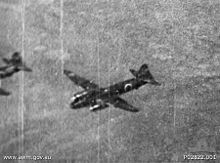 Betty bombers during an air raid over Darwin, Australia..
Betty bombers during an air raid over Darwin, Australia..
- G4M2 Model 22
- The base model, the first production example completed in July 1943. Introduced bulged bomb bay doors from 65th aircraft onwards, and an optically flat panel in the nose cone from the 105th aircraft onwards.
- G4M2 Model 22Ko
- Very similar to previous model. Carried Type 3 Ku Mark 6 search radar and was armed with two 20 mm Type 99 Mark 1 cannons replacing the 7.7 mm machine guns in the lateral positions.
- G4M2 Model 22 Otsu
- Dorsal turret cannon changed to longer-barreled 20 mm Type 99 Mark 2.
- G4M2a Model 24
- Modified Model 22, MK4T Kasei 25 1,340 kW (1,800 hp) engines, with bulged bomb bay doors as standard for larger bomb capacity. Externally distinguishable from the Model 22 by a carburetor air intake on the top of the engine cowling.
- G4M2a Model 24 Ko/Otsu
- Armament similar to Model 22 Ko/Otsu respectively.
- G4M2a Model 24 Hei
- Modified 24 Otsu, with one 13.2 mm (.51 in) Type 2 machine gun mounted in tip of the nose cone, radar antenna relocated from that position to above the nose cone.
- G4M2b Model 25
- One G4M2a modified to MK4T-B Kasei 25 Otsu 1,360 kW (1,825 hp) engines. Only experimental.
- G4M2c Model 26
- Two G4M2a modified to MK4T-B Ru Kasei 25b 1,360 kW (1,825 hp) engines with turbochargers.
- G4M2d Model 27
- One G4M2 modified to MK4V Kasei 27 1,340 kW (1,800 hp) engines.
- G4M2e Model 24 Tei
- Special version for the transport of the ramming attack bomb plane Kugisho/Yokosuka MXY-7 Ohka ("Baka") Model 11, conversions of G4M2a Models 24 Otsu and 24 Hei. Had armour protection for the pilots and fuselage fuel tanks.
- MXY11 Yokosuka Navy Type 1 Attack Bomber
- Ground Decoy Non-flying replica of Mitsubishi G4M2 developed by Yokosuka
G4M3
- G4M3 Model 34
- Redesigned G4M2 with added self-sealing fuel tanks, improved armor protection and an entirely new tail gunner's compartment similar to that of late model B-26 Marauders. Wings were also redesigned and the horizontal tailplane was given dihedral. Armed with 2 × 7.7 mm Type 92 machine guns in nose cabin and in both side positions, and 1 × 20 mm Type 99 Model 1 cannon in dorsal turret and tail. Entered production in October 1944 in G4M3a Model 34 Ko form with 20 mm cannon in side positions instead of machine guns.
- G4M3a Model 34 Otsu and Hei
- Similar modifications as in corresponding Model 24 variants.
- G4M3 Model 36
- Prototype. Two G4M2 Model 34 modified to Mitsubishi MK4-T Kasei 25b Ru 1,360 kW (1,825 hp) engines.
G6M1
- G6M1 Japanese Navy Long Range Heavy Fighter Type 1
- Initial model of the series, armed with 20 mm Type 99 cannons between each side of fuselage and in tail, 1 × 7.7 mm machine gun in nose cabin and 1 × 30 mm cannon in front ventral position; 30 built.
- G6M1-K Trainer, Japanese Navy Type 1
- Converted G6M1s.
- G6M1-L2 Transport Type 1, Japanese Navy
- Modified as transports.
Operators
- Imperial Japanese Navy Air Service operated the type during 1941–1945 in a total of 37 kokutai (air groups).
- Royal Air Force operated at least one captured aircraft for evaluation purposes.[4]
- United States Air Force, like the RAF, operated captured aircraft for evaluation.[5][6]
Specifications (G4M1, Model 11)
Data from Airreview's Japanese Navy Aircraft In The Pacific War[7]
General characteristics
- Crew: 7 (main-pilot, co-pilot, navigator/bombardier/nose gunner, captain/top turret gunner, radio operator/waist gunner, engine mechanic/waist gunner, tail gunner)
- Length: 19.97 m (65 ft 6¼ in)
- Wingspan: 24.89 m (81 ft 7¾ in)
- Height: 4.9 m (16 ft 1 in (in a horizontal position))
- Wing area: 78.13 m² (840.9 ft²)
- Airfoil: Mitsubishi type
- Empty weight: 6,741 kg (14,860 lb)
- Loaded weight: 9,500 kg (20,944 lb)
- Max takeoff weight: 12,860 kg (28,350 lb)
- Powerplant: 2 × Mitsubishi MK4A-11 "Kasei" (Fire star) 14 cylinder radial engines, 1,141 kW (1,530 hp) each
- Propellers: 4-bladed Hamilton Standard licensed Sumitomo constant speed variable-pitch
Performance
- Maximum speed: 428 km/h (230 kn, 265 mph)
- Cruise speed: 315 km/h (175 kn, 196 mph)
- Stall speed: 120 km (75 mph)
- Range: 2,852 km, one way (1,540 nmi, 1,771 mi, one way (overloaded: 5,040 km (2721 nmi, 3,132 mi))[N 2])
- Service ceiling: 8,500 m (27,890 ft)
- Rate of climb: 550 m/min (1,800 ft/min)
Armament
- Guns: 1× 20 mm Type 99 cannon (tail turret), 4× 7.7 mm Type 92 machine gun (nose turret ×1, waist positions ×2, top turret ×1)
- Bombs: 1× 858 kg (1,892 lb) Type 91 Kai-3 (improved model 3) aerial torpedo or 1× 800 kg (1,764 lb) bomb or 4× 250 kg (551 lb) bombs
See also
- Related development
- Aircraft of comparable role, configuration and era
- Bristol Beaufort
- Heinkel He 111
- Martin B-26 Marauder
- North American B-25 Mitchell
- Vickers Wellington
References
- Notes
- Citations
- ^ Francillon 1979, pp. 56–59.
- ^ Wheeler, Barry C. The Hamlyn Guide to Military Aircraft Markings. London: Chancellor Press, 1992. ISBN 1-851-52582-3.
- ^ Fumio 1958, p. ?.
- ^ Francillon 1969, p. 62.
- ^ "TAIC-SWPA No Number Mitsubishi G4M2 Betty (Captured USAAF Mitsubishi G4M "Betty")." j-aircraft.com. Retrieved: 17 October 2010.
- ^ Francillon 1969, p. 63.
- ^ Aoki 1972, pp. 128–136.
- Bibliography
- Aoki, Hideo. "Kugisho Suicide Attacker "Oka" (MXY7) Baka." Airreview's Japanese Navy Aircraft In The Pacific War. Tokyo: Kantosha Co. Ltd., 1972.
- Aoki, Hideo. "Mitsubishi Type 1 Attack Bomber (G4M) Betty." Airreview's Japanese Navy Aircraft In The Pacific War. Tokyo: Kantosha Co. Ltd., 1972.
- Bridgwater, H.C. and Peter Scott. Combat Colours Number 4: Pearl Harbor and Beyond, December 1941 to May 1942. Luton, Bedfordshire, UK: Guideline Publications, 2001. ISBN 0-9539040-6-7.
- Chant, Chris. Aircraft Of World War Two. London: Grange Books PLC., 2001. ISBN 1-84084-329-2.
- Ferkl, Martin. Mitsubishi G4M Betty (in English). Praha, Czech Republic: Revi Publications, 2002. ISBN 80-85957-09-4.
- Francillon, PhD., René J. Imperial Japanese Navy Bombers of World War Two. Windsor, Berkshire, UK: Hylton Lacy Publishers Ltd., 1969. ISBN 0-85064-022-9.
- Francillon, PhD., René J. Japanese Aircraft of the Pacific War. London: Putnam & Company Ltd., 1979. ISBN 0-370-30251-6.
- Francillon, PhD., René J. Mitsubishi G4M "Betty" & Okha Bomb (Aircraft in Profile 210). Windsor, Berkshire, UK: Profile Publications Ltd., 1971.
- Fumio, Iwaya. Chuko (Medium Attack Bomber). Tokyo: Hara Shobo, 1958.
- Green, William. Famous Bombers of the Second World War. London: Macdonald and Jane's Publishers Ltd., 1975 (Second edition of 1959 book, reprinted at least twice: 1976 and 1977). ISBN 0-356-08333-0.
- Gunston, Bill. The Illustrated Encyclopedia of Combat Aircraft of World War II. London: Salamander Books Ltd., (Third impression ) 1979. ISBN 0-89673-000-X.
- Horodyski, Joseph M. "British Gamble In Asian Waters". Military Heritage. Volume 3, No. 3, December 2001, pp. 68–77. (sinking of the British battleship Prince of Wales and battlecruiser Repulse by Japanese on 10 December 1941 upon U.S. entry into World War II).
- Morgan, Eric B. "Mitsubishi G4M Betty." Twentyfirst Profile, Vol. 2, No. 17. New Milton, Hantfordshire, UK: 21st Profile Ltd., ISBN 0-961-8120-11.
- Nowicki, Jacek. Mitsubishi G4M "Betty" (in Polish). Warszawa, Poland: Wydawnictwo Militaria, 1998. ISBN 83-7219-020-8.
- Tagaya, Osamu. Mitsubishi Type 1 Rikko Betty Units of World War 2. London: Osprey Publishing, 2001. ISBN 1-84176-082-X.
- Thorpe, Donald W. Japanese Naval Air Force Camouflage and Markings World War II. Fallbrook, California: Aero Publishers Inc., 1977. ISBN 0-8168-6587-6 (pbk.), ISBN 0-8168-6583-3 (hc.).
External links
Aircraft produced by Mitsubishi Aircraft Company, Mitsubishi Heavy Industries,
and Mitsubishi Aircraft CorporationCompany designations Imperial Japanese Army short designations Imperial Japanese Navy short designations Japanese Self-Defense Force designations World War II Allied reporting names Japanese Navy Land Based Bomber Designations World War II Allied reporting names for Japanese aircraft Aircraft in Japanese service Abdul • Alf • Ann • Babs • Baka • Belle • Betty • Bob • Buzzard • Cedar • Cherry • Clara • Claude • Cypress • Dave • Dick • Dinah • Dot • Edna • Emily • Eva • Eve • Frances • Frank • Gander • George • Glen • Goose • Grace • Gwen • Hamp • Hank • Hap • Helen • Hickory • Ida (Tachikawa Ki-36) • Ida (Tachikawa Ki-55) • Irving • Jack • Jake • Jane • Jean • Jerry • Jill • Jim • Judy • Kate • Kate 61 • Laura • Lily • Liz • Lorna • Loise • Louise • Luke • Mabel • Mary • Mavis • Myrt • Nate • Nell • Nick • Norm • Oak • Oscar • Pat • Patsy • Paul • Peggy • Perry • Pete • Pine • Rex • Rita • Rob • Rufe • Ruth • Sally • Sally III • Sam • Sandy • Slim • Sonia • Spruce • Stella • Steve • Susie • Tabby • Tess • Thalia • Thelma • Theresa • Thora • Tina • Tillie • Toby • Tojo • Tony • Topsy • Val • Willow • Zeke • Zeke 32
Nonexistent aircraft thought to be in Japanese service Adam • Ben • Doris • Gus • Harry • Ione • Joe • Joyce • Julia • June • Norma • Omar • Ray
Foreign aircraft erroneously thought to be in Japanese service Lists relating to aviation General Aircraft (manufacturers) · Aircraft engines (manufacturers) · Airlines (defunct) · Airports · Civil authorities · Museums · Registration prefixes · Rotorcraft (manufacturers) · TimelineMilitary Accidents/incidents Records Categories:- Japanese bomber aircraft 1930–1939
- World War II Japanese medium bombers
- Mitsubishi aircraft
- World War II Japanese torpedo bombers
Wikimedia Foundation. 2010.


